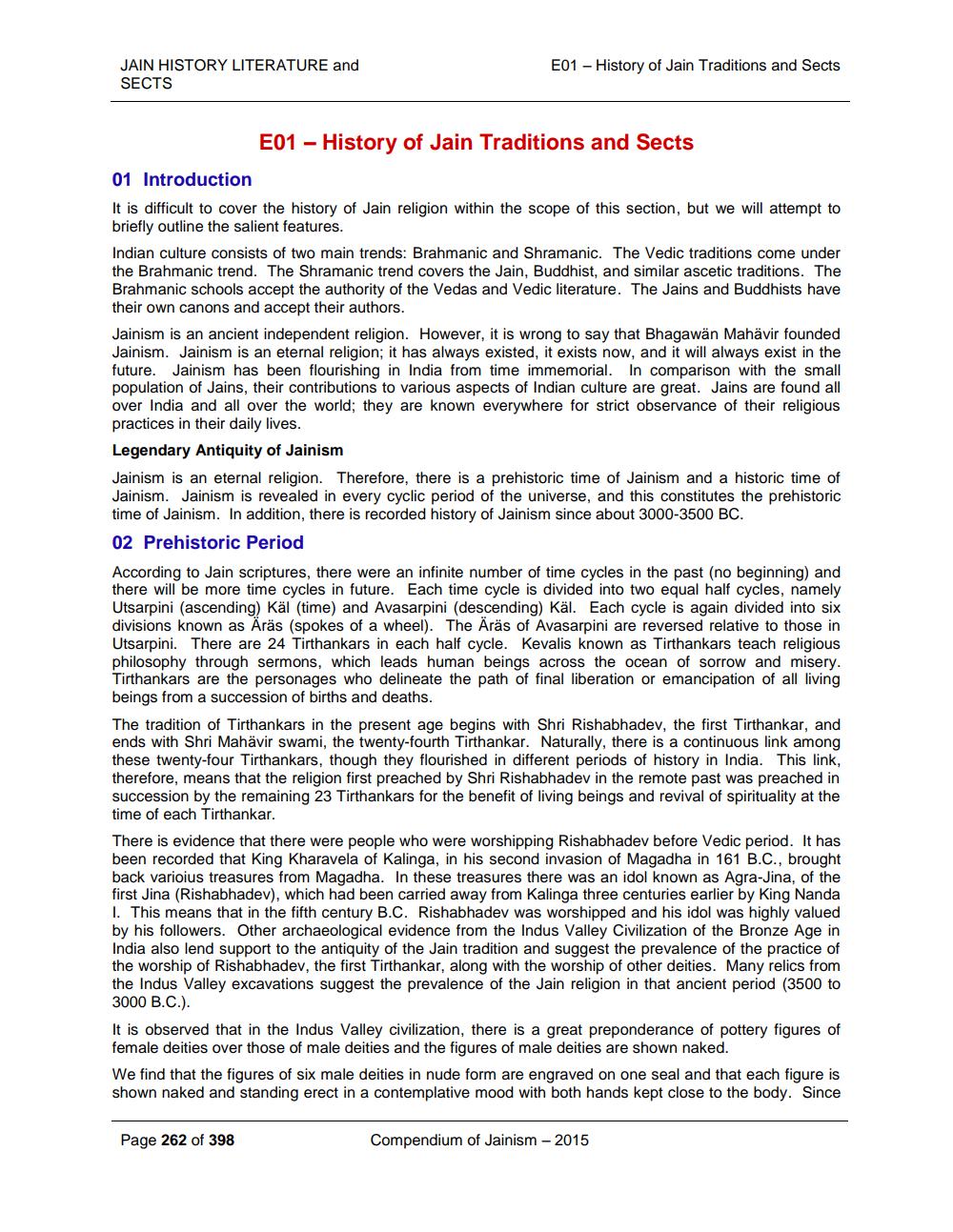________________
JAIN HISTORY LITERATURE and SECTS
E01 - History of Jain Traditions and Sects
E01 - History of Jain Traditions and Sects
01 Introduction It is difficult to cover the history of Jain religion within the scope of this section, but we will attempt to briefly outline the salient features. Indian culture consists of two main trends: Brahmanic and Shramanic. The Vedic traditions come under the Brahmanic trend. The Shramanic trend covers the Jain, Buddhist, and similar ascetic traditions. The Brahmanic schools accept the authority of the Vedas and Vedic literature. The Jains and Buddhists have their own canons and accept their authors. Jainism is an ancient independent religion. However, it is wrong to say that Bhagawan Mahävir founded Jainism. Jainism is an eternal religion; it has always existed, it exists now, and it will always exist in the future. Jainism has been flourishing in India from time immemorial. In comparison with the small population of Jains, their contributions to various aspects of Indian culture are great. Jains are found all over India and all over the world; they are known everywhere for strict observance of their religious practices in their daily lives. Legendary Antiquity of Jainism Jainism is an eternal religion. Therefore, there is a prehistoric time of Jainism and a historic time of Jainism. Jainism is revealed in every cyclic period of the universe, and this constitutes the prehistoric time of Jainism. In addition, there is recorded history of Jainism since about 3000-3500 BC. 02 Prehistoric Period According to Jain scriptures, there were an infinite number of time cycles in the past (no beginning) and there will be more time cycles in future. Each time cycle is divided into two equal half cycles, namely Utsarpini (ascending) Käl (time) and Avasarpini (descending) Käl. Each cycle is again divided into six divisions known as Aräs (spokes of a wheel). The Äräs of Avasarpini are reversed relative to those in Utsarpini. There are 24 Tirthankars in each half cycle. Kevalis known as Tirthankars teach religious philosophy through sermons, which leads human beings across the ocean of sorrow and misery. Tirthankars are the personages who delineate the path of final liberation or emancipation of all living beings from a succession of births and deaths. The tradition of Tirthankars in the present age begins with Shri Rishabhadev, the first Tirthankar, and ends with Shri Mahävir swami, the twenty-fourth Tirthankar. Naturally, there is a continuous link among these twenty-four Tirthankars, though they flourished in different periods of history in India. This link, therefore, means that the religion first preached by Shri Rishabhadev in the remote past was preached in succession by the remaining 23 Tirthankars for the benefit of living beings and revival of spirituality at the time of each Tirthankar. There is evidence that there were people who were worshipping Rishabhadev before Vedic period. It has been recorded that King Kharavela of Kalinga, in his second invasion of Magadha in 161 B.C., brought back varioius treasures from Magadha. In these treasures there was an idol known as Agra-Jina, of the first Jina (Rishabhadev), which had been carried away from Kalinga three centuries earlier by King Nanda 1. This means that in the fifth century B.C. Rishabhadev was worshipped and his idol was highly valued by his followers. Other archaeological evidence from the Indus Valley Civilization of the Bronze Age in India also lend support to the antiquity of the Jain tradition and suggest the prevalence of the practice of the worship of Rishabhadev, the first Tirthankar, along with the worship of other deities. Many relics from the Indus Valley excavations suggest the prevalence of the Jain religion in that ancient period (3500 to 3000 B.C.). It is observed that in the Indus Valley civilization, there is a great preponderance of pottery figures of female deities over those of male deities and the figures of male deities are shown naked. We find that the figures of six male deities in nude form are engraved on one seal and that each figure is shown naked and standing erect in a contemplative mood with both hands kept close to the body. Since
Page 262 of 398
Compendium of Jainism - 2015




